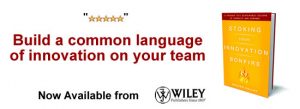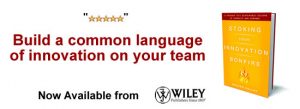The 3 Essential Elements of Innovation
“To be a true innovation, a product, service, or company has to have three essential elements: it has to be unique, it has to be valuable, and it has to be worthy of exchange.”
(excerpted from  Breaking Away: How Great Leaders Create Innovation that Drives Sustainable Growth–and Why Others Fail. (McGraw-Hill 2011)
Virtually every business leader today would agree that understanding and mastering innovation is one of the most important challenges companies face. Innovation has been the subject of debate, discussion, study, and more than a few arguments over the past hundred years. So when we began to talk about innovation with business leaders, it wasn’t surprising that no two thought about it in the same way.
Cammie Dunaway, executive vice president of marketing and sales for Nintendo Americas, describes it as “the point where consumer insight, market opportunity, and development of a product or service intersect.†Ajay Banga, president and CEO of Master-Card, defi nes it as “an idea that is inherently scalable. If you can’ scale it, it’s not really innovation.†Bill Ford, executive chairman of Ford Motor Company, simply says that innovation comprises “products and processes that make people’s lives better.â€
None of these answers are right or wrong; they are just different. It’s this difference in thinking about what innovation is that makes talking about it, maximizing it, and in some cases actually doing it confusing.
The reason for this confusion is tragically simple. Over time, the word has come to be used as an umbrella term for everything from true breakthroughs, like the hybrid car, to the modification of product features or processes that could then be labeled “new.†Renovations are not innovations. Tweaking technology to make a product more current or loading it with features to keep up with the competition is not setting the bar any higher. To be a true innovation, a product, service, or company has to have three essential elements: it has to be unique, it has to be valuable, and it has to be worthy of exchange.
image credit: McGraw Hill
Don’t miss a post (4,000+) – Subscribe to our RSS feed and join our Innovation Excellence group!
 Named by BusinessWeek as one of the “100 Most Influential Search Consultants in the worldâ€, Jane Stevenson is Vice Chairman, Board & CEO Services at Korn/Ferry International (Atlanta/New York). An industry expert on recruiting leaders, Jane was responsible for bringing in many of the first Chief Innovation Officers and CEOs who focused on growth through innovation. Jane is the coauthor of  Breaking Away: How Great Leaders Create Innovation that Drives Sustainable Growth–and Why Others Fail. (McGraw-Hill 2011).
Named by BusinessWeek as one of the “100 Most Influential Search Consultants in the worldâ€, Jane Stevenson is Vice Chairman, Board & CEO Services at Korn/Ferry International (Atlanta/New York). An industry expert on recruiting leaders, Jane was responsible for bringing in many of the first Chief Innovation Officers and CEOs who focused on growth through innovation. Jane is the coauthor of  Breaking Away: How Great Leaders Create Innovation that Drives Sustainable Growth–and Why Others Fail. (McGraw-Hill 2011).
 Named by BusinessWeek as one of the worlds “Top 25 Masters of Innovationâ€, Bilal Kaafarani is Chief Innovation Officer and Group President for Yildiz Holding (owner of Godiva, Ulker and 90+ other global brands) and Vice Chairman of Northstar Innovation in Istanbul, Turkey. A global innovation executive at P&G, Kraft, FritoLay, PepsiCo International and The Coca-Cola Company, he has worked with top brands and developed many innovations under his leadership. Bilal is the coauthor of  Breaking Away (McGraw-Hill 2011).
Named by BusinessWeek as one of the worlds “Top 25 Masters of Innovationâ€, Bilal Kaafarani is Chief Innovation Officer and Group President for Yildiz Holding (owner of Godiva, Ulker and 90+ other global brands) and Vice Chairman of Northstar Innovation in Istanbul, Turkey. A global innovation executive at P&G, Kraft, FritoLay, PepsiCo International and The Coca-Cola Company, he has worked with top brands and developed many innovations under his leadership. Bilal is the coauthor of  Breaking Away (McGraw-Hill 2011).
NEVER MISS ANOTHER NEWSLETTER!
LATEST BLOGS
The Second Coming of the Retail Health Clinic
There used to be a day when you could go to your local barber and get all sorts of wonderful…
Read MoreCan Microsoft out-innovate Google?
Microsoft announced today a round of updates to its Live Search offering. Searchengineland had a good story on the developments.…
Read More




